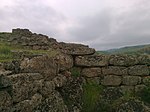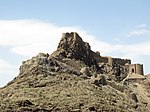Shahdiz
| Shahdiz | |
|---|---|
شاهدز | |
| Near Isfahan, Iran | |
 | |
| Coordinates | 32°35′48″N 51°38′38″E / 32.59667°N 51.64389°E |
| Type | Fortress |
| Site information | |
| Condition | In ruins |
| Site history | |
| In use | 1107 |
| Fate | Demolished |
| Battles/wars | Siege of Shahdiz |

Dizkuh (
Muhammad Tapar's anti-Nizari campaign. Its conspicuous, picturesque ruins lie about 8 km south of Isfahan on a subpeak of Mount Soffeh
.
History
Dizkuh was a fortress in central
Seljuq Empire.[1]
The historian
Malikshah, but it is more likely that it dates back earlier, even as early as the pre-Islamic Sasanian period, and the Seljuq sultan simply rebuilt the castle which was near his capital. Since then, the name Shahdiz became more common.[1]
The castle gained its fame due to the activities of the
Ismaili castles of Persia. Ahmad began to collect taxes from nearby districts.[1] He had reportedly converted 30,000 people in Isfahan. Shahdiz was strategically important as it guarded the main route to Isfahan, the Seljuq capital city. Its capture had been a major strategic success for the Nizaris.[2]
Siege of Shahdiz
| Siege of Shahdiz | |||||||||
|---|---|---|---|---|---|---|---|---|---|
| Part of Muhammad I's campaign in the
Nizari–Seljuk wars | |||||||||
| |||||||||
| Belligerents | |||||||||
|
Seljuq Empire | Nizari Ismailis | ||||||||
| Commanders and leaders | |||||||||
| Sultan Muhammad I Tapar |
Da'i Ahmad ibn Abd al-Malik ibn Attash | ||||||||
| Strength | |||||||||
| Large force |
Small force ~80 men in the final battle | ||||||||
| Casualties and losses | |||||||||
| Unknown | Most of the force in the final battle | ||||||||
In 1107, soon after gaining power, Seljuq sultan
Ismaili castles in Arrajan and Quhistan, and the remainder, around eighty men in all, who held only a wing of the fortress, was to surrender and then go to Alamut after receiving the news of the arrival of their fellow Ismailis. This news was received, but Ahmad refused to leave the fortress, apparently deciding to fight to the end. The Seljuqs attacked the fortress, and Ahmad and his small group of fighters defended themselves gallantly from tower to tower.[1][3] Most of the Ismaili fighters were killed, while a few managed to escape. Ahmad was captured, while his wife committed suicide. Ahmad and his son were executed and their heads were sent to the Abbasid Caliph Al-Mustazhir in Baghdad. The castle was demolished by the Seljuq sultan, who feared its recapture by the Ismailis. Apparently, the Khanlanjan fortress, a nearby Ismaili stronghold, was also destroyed during this campaign. The Nizari Ismailis therefore lost their influence in the Isfahan region.[1][3]
See also
- List of Ismaili castles
References
- ^ Encyclopaedia Iranica. Retrieved 5 October 2018.
- ^ Daftary, Dr. Farhad. "The Mediaeval Ismailis of the Iranian Lands | The Institute of Ismaili Studies". www.iis.ac.uk. Archived from the original on 3 August 2016. Retrieved 1 April 2020.
- ^ ISBN 9780521429740.





















